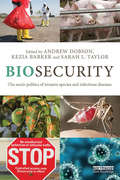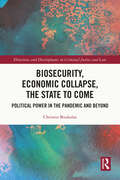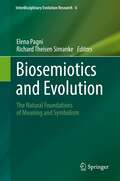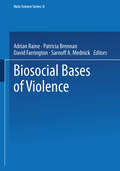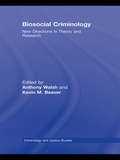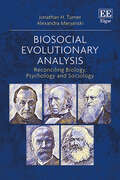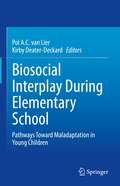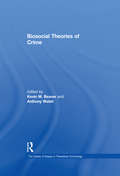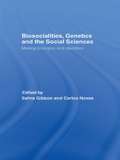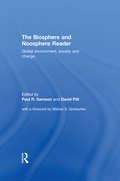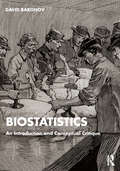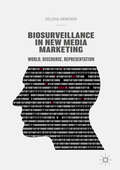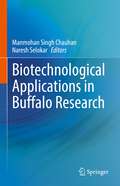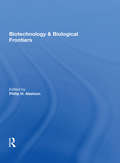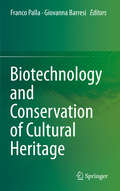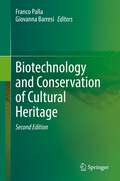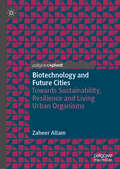- Table View
- List View
Biosecurity: The Socio-Politics of Invasive Species and Infectious Diseases
by Andrew Dobson Kezia Barker Sarah L. TaylorBiosecurity is the assessment and management of potentially dangerous infectious diseases, quarantined pests, invasive (alien) species, living modified organisms, and biological weapons. It is a holistic concept of direct relevance to the sustainability of agriculture, food safety, and the protection of human populations (including bio-terrorism), the environment, and biodiversity. Biosecurity is a relatively new concept that has become increasingly prevalent in academic, policy and media circles, and needs a more comprehensive and inter-disciplinary approach to take into account mobility, globalisation and climate change. In this introductory volume, biosecurity is presented as a governance approach to a set of concerns that span the protection of indigenous biological organisms, agricultural systems and human health, from invasive pests and diseases. It describes the ways in which biosecurity is understood and theorized in different subject disciplines, including anthropology, political theory, ecology, geography and environmental management. It examines the different scientific and knowledge practices connected to biosecurity governance, including legal regimes, ecology, risk management and alternative knowledges. The geopolitics of biosecurity is considered in terms of health, biopolitics and trade governance at the global scale. Finally, biosecurity as an approach to actively secure the future is assessed in the context of future risk and uncertainties, such as globalization and climate change.
Biosecurity, Economic Collapse, the State to Come: Political Power in the Pandemic and Beyond
by Christos BoukalasThis book offers an in-depth critical account of the state’s responses to the biosecurity and the economic crises. It is thus the first study to address both crises ensuing from the pandemic, and to synthesise the responses to them in a comprehensive account of political power. What kind of state emerges from the pandemic? The pandemic caused two crises, in biosecurity and in the economy. The state was forced to tackle both; but subduing one inevitably exacerbated the other. Emerging from the impossible task of handling two conflicting crises is a new form of state, the state to come. Addressing biosecurity, the book deciphers its key modalities, epistemic premises, its law, the threat it aims to oppose, and the ways in which it relates to public health and society —especially its extraordinary power to suspend society. Addressing the economic crisis, the book deciphers the actuality and prospects of both the economy and the state’s economic policy. It claims that economic policy is now dual: it adopts countercyclical measures to serve and entrench a neoliberal economy. The responses to the twin crises inform the outline of the emerging state: its structure, logic, and legality; its power and its relation to society. This is a state of extraordinary power; but its only purpose is to preserve the social order intact. It is a despotic state: powerful, and set to impose social stasis. This book offers groundbreaking analysis based on our pandemic experience. It is indispensable for critical scholars and students in Politics, Security Studies, Sociology, Law, Political Economy and Public Health.
Biosecurity, Economic Collapse, the State to Come: Political Power in the Pandemic and Beyond
by Christos BoukalasThis book offers an in-depth critical account of the state’s responses to the biosecurity and the economic crises. It is thus the first study to address both crises ensuing from the pandemic, and to synthesise the responses to them in a comprehensive account of political power. What kind of state emerges from the pandemic? The pandemic caused two crises, in biosecurity and in the economy. The state was forced to tackle both; but subduing one inevitably exacerbated the other. Emerging from the impossible task of handling two conflicting crises is a new form of state, the state to come. Addressing biosecurity, the book deciphers its key modalities, epistemic premises, its law, the threat it aims to oppose, and the ways in which it relates to public health and society —especially its extraordinary power to suspend society. Addressing the economic crisis, the book deciphers the actuality and prospects of both the economy and the state’s economic policy. It claims that economic policy is now dual: it adopts countercyclical measures to serve and entrench a neoliberal economy. The responses to the twin crises inform the outline of the emerging state: its structure, logic, and legality; its power and its relation to society. This is a state of extraordinary power; but its only purpose is to preserve the social order intact. It is a despotic state: powerful, and set to impose social stasis. This book offers groundbreaking analysis based on our pandemic experience. It is indispensable for critical scholars and students in Politics, Security Studies, Sociology, Law, Political Economy and Public Health.
The Biosecurity Individual: A Cultural Critique of the Intersection between Health, Security, and Identity (American Culture Studies #43)
by Frederike OffizierDiscoveries in biomedicine and biotechnology, especially in diagnostics, have made prevention and (self)surveillance increasingly important in the context of health practices. Frederike Offizier offers a cultural critique of the intersection between health, security and identity, and explores how the focus on risk and security changes our understanding of health and transforms our relationship to our bodies. Analyzing a wide variety of texts, from life writing to fiction, she offers a critical intervention on how this shift in the medical gaze produces new paradigms of difference and new biomedically facilitated identities: biosecurity individuals.
Biosemiotics and Evolution: The Natural Foundations of Meaning and Symbolism (Interdisciplinary Evolution Research #6)
by Elena Pagni Richard Theisen SimankeThis book reviews the evolution of Biosemiotics and gives an outlook on the future of this interdisciplinary new discipline. In this volume, the foundations of symbolism are transformed into a phenomenological, technological, philosophical and psychological discussion enriching the readers’ knowledge of these foundations. It offers the opportunity to rethink the impact that evolution theory and the confirmations about evolution as a historical and natural fact, has had and continues to have today. The book is divided into three parts:Part I Life, Meaning, and InformationPart II Semiosis and EvolutionPart III Physics, medicine, and bioenergetics It starts by laying out a general historical, philosophical, and scientific framework for the collection of studies that will follow. In the following some of the main reference models of evolutionary theories are revisited: Extended Synthesis, Formal Darwinism and Biosemiotics. The authors shed new light on how to rethink the processes underlying the origins and evolution of knowledge, the boundary between teleonomic and teleological paradigms of evolution and their possible integration, the relationship between linguistics and biological sciences, especially with reference to the concept of causality, biological information and the mechanisms of its transmission, the difference between physical and biosemiotic intentionality, as well as an examination of the results offered or deriving from the application in the economics and the engineering of design, of biosemiotic models for the transmission of culture, digitalization and proto-design. This volume is of fundamental scientific and philosophical interest, and seen as a possibility for a dialogue based on theoretical and methodological pluralism. The international nature of the publication, with contributions from all over the world, will allow a further development of academic relations, at the service of the international scientific and humanistic heritage.
Biosocial Bases of Violence (Nato Science Series A: #292)
by Adrian Raine Patricia Brennan David P. Farrington Sarnoff A. MednickProceedings of a NATO ASI held in Rhodes, Greece, May 12-21, 1996
Biosocial Criminology: New Directions in Theory and Research (Criminology and Justice Studies)
by Anthony Walsh Kevin M. BeaverIdeal for use, either as a second text in a standard criminology course, or for a discrete course on biosocial perspectives, this book of original chapters breaks new and important ground for ways today's criminologists need to think more broadly about the crime problem.
Biosocial Criminology: New Directions in Theory and Research (Criminology and Justice Studies)
by Anthony Walsh Kevin M. BeaverIdeal for use, either as a second text in a standard criminology course, or for a discrete course on biosocial perspectives, this book of original chapters breaks new and important ground for ways today's criminologists need to think more broadly about the crime problem.
Biosocial Evolutionary Analysis: Reconciling Biology, Psychology and Sociology
by Jonathan H. Turner Alexandra MaryanskiThis authoritative book proposes a methodological and theoretical strategy for developing sociological explanations of the socio-cultural universe. Jonathan H. Turner and Alexandra Maryanski discuss the problems that persist in explaining the socio-cultural universe using only biological and psychological approaches and outline new strategies for understanding the evolution of human beings and their biological nature.Through exploring human evolution, human nature, human behaviours and patterns of social organisation, Turner and Maryanski demonstrate that evolutionary explanations of behaviours and patterns can be drawn from modern synthesis in biology. They also explain why certain dimensions of the socio-cultural universe can only be understood using purely sociological approaches to evolutionary analysis. They expertly analyse alternative biologically-based strategies for explaining the evolution of human beings and a purely sociological strategy for understanding the emergent properties of human socio-cultural formations.Innovative in its approach, this timely book will be of great interest to scholars interested in the fields of science and technology studies, sociology and sociological theory, cultural sociology, social psychology, and social policy. It will also be highly beneficial to those looking to better understand the optimum methodological strategies for understanding the biology of human nature.
Biosocial Interplay During Elementary School: Pathways Toward Maladaptation in Young Children
by Pol A. C. van Lier Kirby Deater-DeckardThis book examines the effects of social relations during primary school on children’s neurobiology and pathways to maladaptation. It explores the ways in which after the transition to primary education children, supervised by teachers, need to function with their peers. The volume addresses issues affecting 10% to 20% of children who become poorly accepted or victimized by peers, receive low support by teachers or even have conflictual relations with teachers, and may perceive the classroom as a whole as nonsupportive. Key areas of coverage include:Detrimental effects of such social experiences, providing an overview of how such experiences affect children’s neurobiology factors to understand why these children develop maladaptive outcomes.Manifestations of social relations, their complexity, interrelations, and pathways leading to the maladaptive outcomes.How genetic factors may evoke children’s social environment and make them susceptible to its impact (e.g., findings on DNA methylation at both epigenome-wide level as well as on particular loci on candidate genes).Links between social environmental stressors and the psychophysiology of elementary school children and reviews both links with the autonomic nervous system as well as with the HPA-axis.The impact of social experiences on neurocognitive function development, decision making, and structural and functional brain development and discusses implications for research, prevention, and intervention. Biosocial Interplay During Elementary School is a must-have resource for researchers, professors, and graduate students as well as clinicians and other professionals in clinical child, school, and developmental psychology, educational psychology/policy and politics, social work, neuroscience, public health, and all related disciplines.
Biosocial Theories of Crime
by KevinM. BeaverBiosocial criminology is an emerging perspective that highlights the interdependence between genetic and environmental factors in the etiology of antisocial behaviors. However, given that biosocial criminology has only recently gained traction among criminologists, there has not been any attempt to compile some of the "classic" articles on this topic. Beaver and Walsh's edited volume addresses this gap in the literature by identifying some of the most influential biosocial criminological articles and including them in a single resource. The articles covered in this volume examine the connection between genetics and crime, evolutionary psychology and crime, and neuroscience and crime. This volume will be a valuable resource for anyone interested in understanding the causes of crime from a biosocial criminological perspective.
Biosocial Theories of Crime
by KevinM. BeaverBiosocial criminology is an emerging perspective that highlights the interdependence between genetic and environmental factors in the etiology of antisocial behaviors. However, given that biosocial criminology has only recently gained traction among criminologists, there has not been any attempt to compile some of the "classic" articles on this topic. Beaver and Walsh's edited volume addresses this gap in the literature by identifying some of the most influential biosocial criminological articles and including them in a single resource. The articles covered in this volume examine the connection between genetics and crime, evolutionary psychology and crime, and neuroscience and crime. This volume will be a valuable resource for anyone interested in understanding the causes of crime from a biosocial criminological perspective.
Biosocialities, Genetics and the Social Sciences: Making Biologies and Identities
by Sahra Gibbon Carlos NovasBiosocialities, Genetics and the Social Sciences explores the social, cultural and economic transformations that result from innovations in genomic knowledge and technology. This pioneering collection uses Paul Rabinow’s concept of biosociality to chart the shifts in social relations and ideas about nature, biology and identity brought about by developments in biomedicine. Based on new empirical research, it contains chapters on genomic research into embryonic stem cell therapy, breast cancer, autism, Parkinson’s and IVF treatment, as well as on the expectations and education surrounding genomic research. It covers four main themes: novel modes of identity and identification, such as genetic citizenship the role of institutions, ranging from disease advocacy organizations and voluntary organizations to the state the production of biological knowledge, novel life-forms, and technologies the generation of wealth and commercial interests in biology. Including an afterword by Paul Rabinow and case studies on the UK, US, Canada, Germany, India and Israel, this book is key reading for students and researchers of the new genetics and the social sciences – particularly medical sociologists, medical anthropologists and those involved with science and technology studies.
Biosocialities, Genetics and the Social Sciences: Making Biologies and Identities
by Sahra Gibbon Carlos NovasBiosocialities, Genetics and the Social Sciences explores the social, cultural and economic transformations that result from innovations in genomic knowledge and technology. This pioneering collection uses Paul Rabinow’s concept of biosociality to chart the shifts in social relations and ideas about nature, biology and identity brought about by developments in biomedicine. Based on new empirical research, it contains chapters on genomic research into embryonic stem cell therapy, breast cancer, autism, Parkinson’s and IVF treatment, as well as on the expectations and education surrounding genomic research. It covers four main themes: novel modes of identity and identification, such as genetic citizenship the role of institutions, ranging from disease advocacy organizations and voluntary organizations to the state the production of biological knowledge, novel life-forms, and technologies the generation of wealth and commercial interests in biology. Including an afterword by Paul Rabinow and case studies on the UK, US, Canada, Germany, India and Israel, this book is key reading for students and researchers of the new genetics and the social sciences – particularly medical sociologists, medical anthropologists and those involved with science and technology studies.
The Biosphere and Noosphere Reader: Global Environment, Society and Change
by David Pitt Paul R. SamsonThe Reader is the first comprehensive history of the noosphere and biosphere. Drawing on classical influences, modern parallels, and insights into the future, the Reader traces the emergence of noosphere and biosphere concepts within the concept of environmental change. Reproducing material from seminla works, both past and present, key ideas and writings of prominent thinkers are presented, including Bergson, Vernadsky, Lovelock, Russell, Needham, Huxley, Medawar, Toynbee and Boulding, and extensive introductory pieces bu the editors drawattention to common themes and competing ideas. Focussing on issues of origins, theories, parallels and potential, the discussions place issues in a broad context, compare and contrast central concepts with those of the Gaia hypothesis, sustainability and global change, and examine the potential application of noospheric ideas to current debates about culture, education and technology in such realms as the Internet, space exploration, and the emergence of super-consciousness. Literally the `sphere of mind or intellect', the noosphere is aprt of the `realm of the possible' in human affairs, where there is a conscious effort to tackle global issues The noosphere concept captures a number of key contemporary issues - social evolution, global ecology, Gaia, deep ecology and global environmental change - contributing to ongoing debates concerning the implications of emerging technologies.
The Biosphere and Noosphere Reader: Global Environment, Society and Change
by Paul R. Samson David PittThe Reader is the first comprehensive history of the noosphere and biosphere. Drawing on classical influences, modern parallels, and insights into the future, the Reader traces the emergence of noosphere and biosphere concepts within the concept of environmental change. Reproducing material from seminla works, both past and present, key ideas and writings of prominent thinkers are presented, including Bergson, Vernadsky, Lovelock, Russell, Needham, Huxley, Medawar, Toynbee and Boulding, and extensive introductory pieces bu the editors drawattention to common themes and competing ideas. Focussing on issues of origins, theories, parallels and potential, the discussions place issues in a broad context, compare and contrast central concepts with those of the Gaia hypothesis, sustainability and global change, and examine the potential application of noospheric ideas to current debates about culture, education and technology in such realms as the Internet, space exploration, and the emergence of super-consciousness. Literally the `sphere of mind or intellect', the noosphere is aprt of the `realm of the possible' in human affairs, where there is a conscious effort to tackle global issues The noosphere concept captures a number of key contemporary issues - social evolution, global ecology, Gaia, deep ecology and global environmental change - contributing to ongoing debates concerning the implications of emerging technologies.
Biostatistics: An Introduction and Conceptual Critique
by David BaronovWithout question, biostatistical analysis has contributed to a slew of amazing medical breakthroughs. Yet it also distorts and deforms the holistic and contingent nature of health and medicine. How is it that biostatistics can both sharpen and weaken our understanding of health and medicine? What is unique about the content of health and medicine that so plainly reveals such distortions and deformities? Exploring these questions entails, first, a full survey of the tools and techniques of biostatistical analysis aiding medical breakthroughs. This survey must then be paired with a probe into the conceptual premises of these tools and techniques and how they refashion and reconstitute the inherently qualitative content of health and medicine in preparation for its quantification. We must grasp the statistical machinations at play, both technical and conceptual, that contrive to fit objects to tools rather than fitting tools to objects. This textbook introduces both the procedural methods and the hidden premises of biostatistical analysis.
Biostatistics: An Introduction and Conceptual Critique
by David BaronovWithout question, biostatistical analysis has contributed to a slew of amazing medical breakthroughs. Yet it also distorts and deforms the holistic and contingent nature of health and medicine. How is it that biostatistics can both sharpen and weaken our understanding of health and medicine? What is unique about the content of health and medicine that so plainly reveals such distortions and deformities? Exploring these questions entails, first, a full survey of the tools and techniques of biostatistical analysis aiding medical breakthroughs. This survey must then be paired with a probe into the conceptual premises of these tools and techniques and how they refashion and reconstitute the inherently qualitative content of health and medicine in preparation for its quantification. We must grasp the statistical machinations at play, both technical and conceptual, that contrive to fit objects to tools rather than fitting tools to objects. This textbook introduces both the procedural methods and the hidden premises of biostatistical analysis.
Biosurveillance in New Media Marketing: World, Discourse, Representation
by Selena NemorinAdvertising has long been considered a manipulator of minds and has increased significantly in coercive power since the emergence of research in behavioural psychology. Now with the deployment of neuro-physiological imaging technologies into market contexts, companies are turning to neuromarketing to measure how we think and feel. Data driven models are being used to inform advertising strategies designed to trigger human action at a level beneath conscious awareness. This practice can be understood as a form of consumer biosurveillance: but what is behind the hype? What are the consequences? Biosurveillance in New Media Marketing is a critical reflection on the role that technology is playing in the construction of consumer representations, and its encroachment into the internal lives of individuals and groups. It is a work that examines the relationship between neuromarketing practitioners and machines, and how the discourses and practices emerging from this entanglement are influencing the way we make sense of the world.
Biotechnological Applications in Buffalo Research
by Manmohan Singh Chauhan Naresh SelokarThis book comprehensively reviews the advancements in biotechnological applications for the enhanced production and conservations of buffalo (Bubalus bubalis). The book discusses developments in assisted reproduction to improve productivity and the produce novel products for applications to human health and nutrition. The initial chapters of the book discuss the global distribution and domestications of buffalo, and nutritive values of buffalo milk, while the subsequent sections examine the applications of the genome-wide association traits to identify potential genetic variants affecting important economic traits. It identifies predictive biomarkers for postpartum or peripartum diseased-state and presents potential protein biomarkers for the diagnosis of early pregnancy in buffalo. Lastly, it discusses recent scientific developments such as induced pluripotent stem cells, spermatogonial stem cells, somatic cell nuclear transfer, and buffalo as a model for human biomedical research. This book is a useful source to students, academicians, researchers, and policymakers who are involved in buffalo science and industry.
Biotechnology And Biological Frontiers
by Philip H AbelsonSplit into two sections, Part I of this volume from Science is devoted to a broad sampling of the status of a revolution in applied biology. The emphasis of Part II in this volume is fundamental research rather than techniques or practical applications.
Biotechnology And Biological Frontiers
by Philip H AbelsonSplit into two sections, Part I of this volume from Science is devoted to a broad sampling of the status of a revolution in applied biology. The emphasis of Part II in this volume is fundamental research rather than techniques or practical applications.
Biotechnology and Conservation of Cultural Heritage
by Franco Palla Giovanna BarresiThis book provides detailed insights into the role of microorganisms and microbial products in biodeterioration, conservation and restoration of cultural heritage. Topics to be discussed are microbial colonization and their growth control on both artworks and aerosol of indoor environments such as libraries or museums, as well as human health hazard from exposure to microbial agents. In addition innovative biotechnological protocols and strategies for the removal of undesired layers on artwork surfaces are described in detail. Also the advances and perspectives in this emerging biotechnological field are discussed, supported by the latest original findings.
Biotechnology and Conservation of Cultural Heritage
by Franco Palla Giovanna BarresiThis second fully updated and extended edition of Biotechnology and Conservation of Cultural Heritage provides in-depth insights into the role of different microorganisms and microbial compounds in biodeterioration, conservation and restoration of artworks and artifacts. Latest methods to detect, remove and prevent microbial colonization on artwork surfaces and in air environments of libraries and museums are discussed and illustrated by engaging case studies. Furthermore, this edition covers new case studies on Archaeobiology, exploring ways to perform the molecular biology characterization, restoring and protecting museum taxidermal specimens, preserving and guaranteeing the future integrity. Finally, the use of halloysite-nanotubes is investigated to set up innovative protocols in consolidation and long-term protection of waterlogged and archaeological wood. This book addresses to Biologists, Microbiologists, Conservation Scientists and Conservators who are interested in understanding the role of microorganisms and bioactive molecules in conservation projects.
Biotechnology and Future Cities: Towards Sustainability, Resilience and Living Urban Organisms
by Zaheer AllamThis book explores how biotechnology can lead to the reimagination of cities. In a time where the increasing adoption of technology by cities is leading to unsustainable environmental and economic concerns, biotechnology has enabled new ways of envisioning data and energy storage. Zaheer Allam thus revisits the popular concept of Smart Cities -and its associated Internet of Things (IoT) to explore how the biological sciences, coupled with technology, can be applied to cities; and in doing so, create living urban organisms on an unprecedented scale. This new concept will open up exciting avenues to providing novel solutions for climate change mitigation. The book goes on to address various potential concerns and discusses what regulatory frameworks would be needed to safely implement such a concept. It will be a useful tool for planners, policy makers and engineers as well as for researchers with in interest in the future of our cities.
